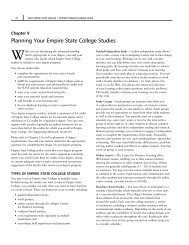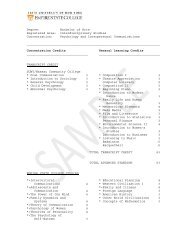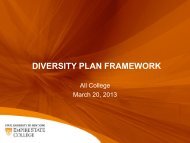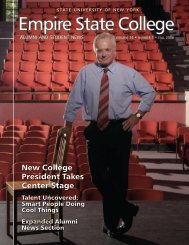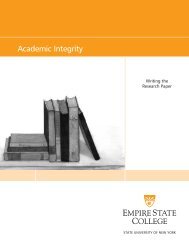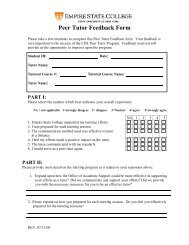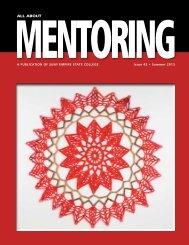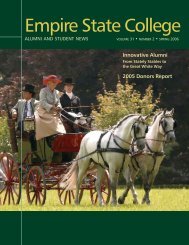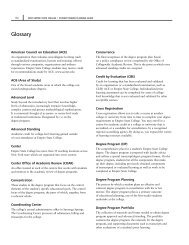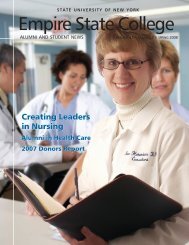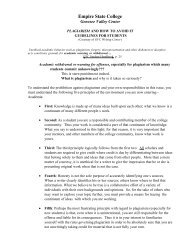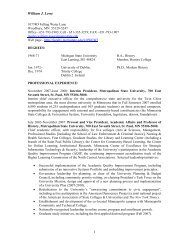Academic Plan 2011-2015 (PDF 524kB) - SUNY Empire State College
Academic Plan 2011-2015 (PDF 524kB) - SUNY Empire State College
Academic Plan 2011-2015 (PDF 524kB) - SUNY Empire State College
Create successful ePaper yourself
Turn your PDF publications into a flip-book with our unique Google optimized e-Paper software.
24 <strong>SUNY</strong> <strong>Empire</strong> <strong>State</strong> <strong>College</strong>: <strong>Academic</strong> <strong>Plan</strong> <strong>2011</strong> - <strong>2015</strong>Objective B1.4: Implement improved planning and design of physical locationsThe overall objective is for the Office of <strong>Academic</strong> Affairs and the Office of Administration tocollaborate to create sets of standards, best practices, and teaching, learning and service objectivesthat incorporate new design models systematically deployed across the college. Procedures forconsultation at all levels of users need to be built in. Units, as well as centers, need to be considered.The planning and design of new or renovated college locations – including floor plans, furniture andinfrastructure – must create the highest quality environment. The physical environment should supportstudent learning and faculty and student collaboration. The infrastructure should include currenttechnology for administrative and educational uses – such as high speed Internet access, wireless andpresentation equipment –installed before occupancy or systematically during renovation, rather thanretro-fitted. As the college is aware, attention must be paid to accommodating disabilities in the designof the physical environment.The academic plan endorses the concept of developing regional hubs among the regional centers.These “hubs” would include faculty and staff from the Center for Distance Learning, the School forGraduate Studies, The Harry Van Arsdale Jr. Center for Labor Studies, and the regional center to betterrecruit, serve and retain students, while creating a culture of collaboration among faculty and staff.Finally, the <strong>Academic</strong> <strong>Plan</strong> proposes incorporating – but also extending beyond – current modelsof mentor-student interaction and the concurrent development of physical spaces that supportmultiple modes of interaction. Thus, planning must consider needs of one mentor, working with asingle student, but also the development of more collective and collaboratively-oriented learningenvironments. This has happened at certain new locations and needs to be institutionalized andimplemented systematically collegewide adjusting for local conditions. Examples of new ideas includecollaborative spaces of various sizes with various equipment for face-to-face and distance conferencing(Center for Distance Learning, 113 West Ave.); one-stop student service and support areas (model forGenesee Valley Center); and modular online learning environments – such as a wireless laboratoryenvironment with moveable furniture that can be configured for individuals, one-to-one academiccoaching and study group learning on demand. The plan also endorses “signature rooms” that canserve as art galleries, small-scale performance spaces and can accommodate orientations and specialevents, as well as instructional needs.Goal B2: Enhance <strong>Academic</strong> Assessment, Preparation and Support forStudents from Admission to Graduation<strong>Empire</strong> <strong>State</strong> <strong>College</strong> has embraced a mission to serve people with a wide range of academic skillsand preparedness. At both graduate and undergraduate levels, we recruit, admit and serve peoplewho have experienced diverse educational trajectories, and who are trying to achieve diverse personaland professional goals. Because <strong>Empire</strong> <strong>State</strong> <strong>College</strong> has embraced an educational model that isunique in ways that create challenges as well as opportunities for students, we must embrace someresponsibilities in terms of admissions, orientation, skills assessment and developmental learnersupport. That is, we must determine what our students need to prosper academically, and thenwe must plan to provide what they need. In short, the academic plan calls for enhanced academicassessment, preparation and support for all students from admission to graduation.




